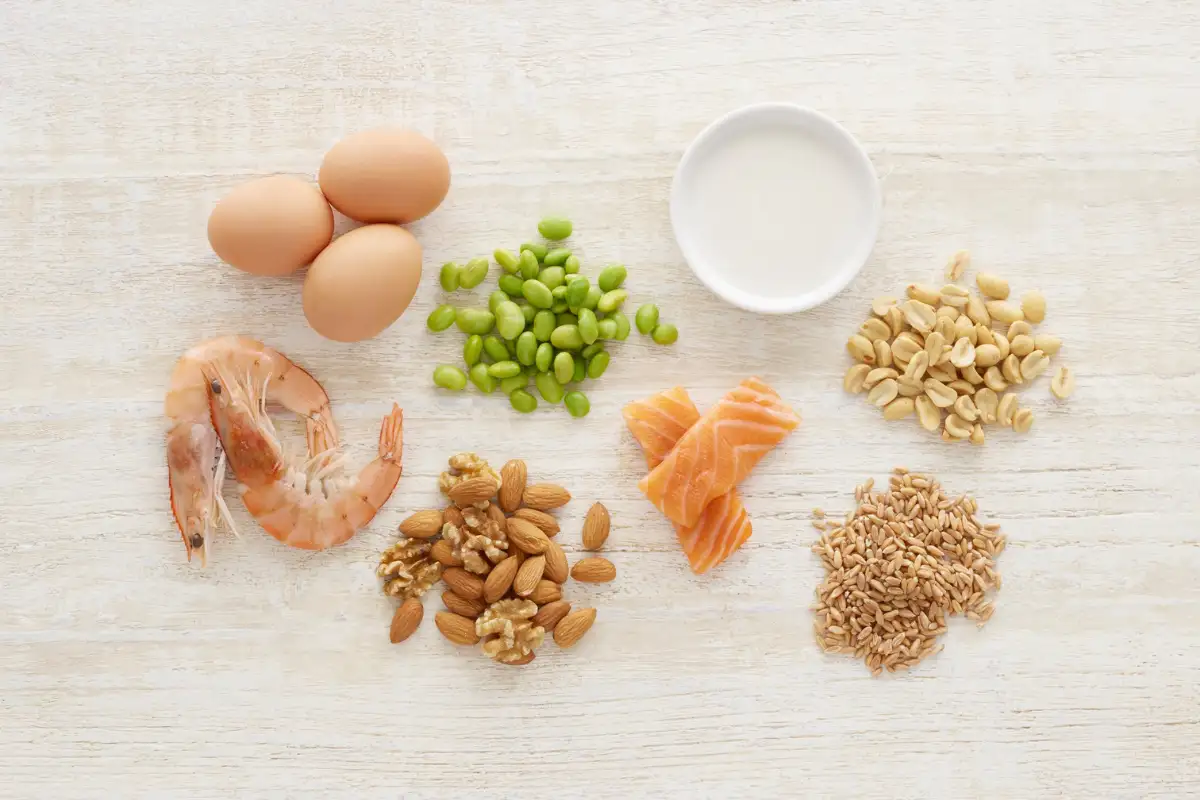
Food sensitivities and intolerances are a source of frustration for many people and can be a confusing and misunderstood aspect of health. Food sensitivities can cause a wide range of symptoms, making it harder to pinpoint the root of the problem. Food sensitivities can even be mistaken for seasonal allergies with similar symptoms.
In this article, we’ll explore some of the most common food sensitivities, how to recognize them, and steps you can take to manage them effectively. It’s all about feeling your best!

What is a Food Sensitivity?
What’s the difference between food sensitivity and a food allergy?
Let’s say you eat a meal out with your friends one day. Immediately after, you start noticing bumps forming on your arms, or your lips or face swell. This is more characteristic of a food allergy. An allergic reaction is an immune response that happens pretty quickly after eating. The body releases histamines as a defense mechanism, which triggers symptoms such as itching, hives, facial swelling, lips, or throat, and difficulty breathing. These symptoms are more immediate and severe.
On the other hand, food sensitivities tend to be more subtle and delayed reactions. These reactions are more often related to digestion. Think bloating, indigestion, abdominal cramping, gas or nausea, and diarrhea or constipation. While these are more common symptoms, food sensitivities can also affect other body areas. You may also experience brain fog, muscle or joint pain, fatigue, headaches, or eczema.
Advertisement
Unlike allergies, food sensitivities are not life-threatening. But if you’re familiar with them, you know they can significantly impact your quality of life.
How Do I Know If I Have a Food Sensitivity?
Identifying food sensitivities can be challenging because symptoms vary from person to person. However, digestive discomfort, headaches, fatigue, and skin issues like eczema are the most common indicators. If you notice any of these symptoms creeping up after eating certain foods, it might be time to investigate.
Keeping a food diary is a great way to start. If you log your food daily, you can see exactly what you’ve been eating and keep notes about any symptoms you may experience. This can be extremely helpful to find patterns and connect the dots between symptoms and certain foods. Even if you don’t use an app or online tracker, simple logging notes on your phone or good old-fashioned pen and paper can be just as helpful. Jot down the time, the food and drinks you consume, and any symptoms you feel throughout the day.
Advertisement
Identifying the Top 10 Most Common Food Sensitivities
1. Dairy
Dairy sensitivities are usually a result of lactose, a natural sugar found in milk. This is one of the most well-known food intolerances. However, not all dairy products have the same amounts of lactose. Cow’s milk and cheese may be a no-go for you, but you may find that you digest goat milk products just fine. This contains lower amounts of lactose.
- Symptoms: Bloating, diarrhea, stomach cramps, gas
- Common Foods: Dairy products like milk, cheese, yogurt, butter, ice cream
- Hidden Sources: Some processed foods like bread, baked goods, salad dressings, instant potatoes, and soups; a filler for medications
2. Gluten
Gluten is a protein naturally found in certain grains, such as wheat, barley, and rye. Its properties help give the dough its elastic texture. However, its structure also makes it more difficult for the GI tract to break down during digestion, leading to digestive discomfort for certain people. Symptoms of gluten intolerance can range from mild to severe. Individuals with severe intolerance may be diagnosed with celiac disease.
- Symptoms: Bloating, diarrhea, constipation, fatigue, joint pain
- Common Foods: Wheat, barley, rye, pasta, bread, cereals
- Hidden Sources: Processed foods like soups, sauces, salad dressings; some candies and meat substitutes
3. Nuts
Nut sensitivities can also range from mild to severe and may be confused with nut allergies. Sensitivity symptoms are less severe reactions typically associated with peanuts and tree nuts.
- Symptoms: Stomach pain, bloating, skin reactions, respiratory issues
- Common Foods: Peanuts, tree nuts (almonds, walnuts, cashews, etc.)
- Hidden Sources: Sauces, baked goods, cereals, oils and flavorings
4. FODMAP Foods
FODMAPs are a group of short-chain carbohydrates that are sometimes poorly absorbed in the gut, which can lead to digestive distress. These foods contain fermentable oligosaccharides, disaccharides, monosaccharides, and polyols. For a complete list of high and low FODMAP foods, click here.
- Symptoms: Bloating, gas, stomach cramps, diarrhea
- Common Foods: Onions, garlic, beans, asparagus, cauliflower, cabbage, mushrooms, peas
- Hidden Sources: Processed foods like sauces, dressing and low-calorie sweeteners
5. Artificial Sweeteners & Sugar Alcohols
These are synthetic or naturally occurring substances used to replace sugar as an ingredient. It can be fairly easy to spot products with artificial sweeteners. Most are marketed as healthier alternatives to sugar with a boasting “Sugar-Free!” label. However, some artificial sweeteners and sugar alcohols can cause problems in the gut, especially when consumed in large amounts.
Advertisement
- Symptoms: Bloating, gas, diarrhea, headaches
- Common Foods: Diet sodas, sugar-free gum, low-calorie packaged foods
- Hidden Sources: “Low-calorie” or “sugar-free” packaged foods
- Common Names: Acesulphame potassium, aspartame, erythritol, isomalt, lactitol, maltitol, polydextrose, saccharin, sorbitol, sucralose, xylitol (This is not an exhaustive list.)
6. Caffeine
Caffeine is a naturally occurring stimulant found in several plant varieties. Caffeine sensitivity varies. It gives some people a welcome boost to help them get through the day, while for others, it can lead to very unpleasant symptoms. Understanding your caffeine tolerance level is essential to assuage reactions.
- Common Symptoms: Jitters, anxiety, rapid heartbeat, stomach upset
- Common Foods: Coffee, tea, energy drinks, chocolate
- Hidden Sources: Certain medications, supplements, and flavored snack products
7. Amines
Amines, including histamine, are chemicals formed when foods age or ferment. Your body will break these down during digestion, but if it cannot do so thoroughly, they can build up in your system and cause symptoms.
- Common Symptoms: Headaches, rashes, hives, digestive issues
- Common Foods: Aged cheeses, cured meats, fermented foods, wine
- Hidden Sources: Leftover foods, especially if stored for extended periods.
8. Sulfites
Sulfites are preservatives found in many processed foods and beverages. They prevent browning and spoilage. However, they can cause reactions, particularly in those with asthma.
- Common Symptoms: Respiratory issues, skin rashes, stomach pain
- Common Foods: Dried fruits, wine, processed foods
- Hidden Sources: Certain medications, cosmetics, and alcoholic beverages
9. Salicylates
Salicylates are chemicals found naturally in many fruits, vegetables, and herbs. They are derived from salicylic acid. Some people are sensitive to salicylates, whether natural or synthetic, leading to various symptoms.
- Common Symptoms: Stomach pain, headaches, fever, sinus inflammation, skin reactions
- Common Foods: Many fruits, vegetables, and spices contain more significant amounts of salicylates. Some examples are tomatoes, berries, broccoli, cucumber, curry, cayenne, and dill. Find a more robust list here.
- Hidden Sources: Many everyday products, such as perfume, shampoo, mouthwash, lotion, and medications, may contain salicylates.
10. Food Coloring
Artificial food colorings are synthetic dyes that enhance the appearance of food and beverages. They are labeled as numbers, such as Red 40, Yellow 5, and Blue 1, and have been linked to hyperactivity and adverse effects in children.
Advertisement
- Common Symptoms: Hyperactivity, skin reactions, headaches, digestive issues
- Common Foods: Candies, cereals, sodas, baked goods, snack foods
- Hidden Sources: Some medications or supplements
Considerations for Intolerance
Preparation Matters
How your food is cooked or prepared can sometimes affect how your body reacts. For example, fermenting or soaking foods may reduce their FODMAP content and make them easier to digest. Removing the skin of fruits and vegetables may help reduce salicylate or amine content. Soaking beans, legumes, and sprouting grains can help overall digestion by removing some antinutrients that cause digestion discomfort.
Eliminating Foods
WAG believes all foods fit into a healthy nutrition plan. However, eliminating the food from your diet for a few weeks can help you identify the problem if you suspect food sensitivity. If symptoms disappear, gradually reintroduce the food in small amounts to test your tolerance. You may find that you can occasionally tolerate small quantities, even if large amounts cause discomfort.
Get to the Root Cause
Food sensitivity testing is an excellent tool for narrowing down specific causes of food reactions. However, food sensitivities are sometimes a symptom of a more significant issue, such as gut dysbiosis or another condition. Working with a healthcare professional to address underlying digestive issues can help improve one's tolerance to certain foods.
Food sensitivities can be challenging to navigate, but understanding the most common culprits and their symptoms is a helpful step. By keeping a food log, paying attention to your body's signals, and considering how food preparation methods impact your symptoms, you can learn how to avoid discomfort.
References:
- Cenni, S., Sesenna, V., Boiardi, G., Casertano, M., Russo, G., Reginelli, A., Esposito, S., & Strisciuglio, C. (2023). The Role of Gluten in Gastrointestinal Disorders: A Review. Nutrients, 15(7), 1615. https://doi.org/10.3390/nu15071615
- Cleveland Clinic. Celiac Disease. Retrieved from: https://my.clevelandclinic.org/health/diseases/14240-celiac-disease
- Vandeputte, D., & Joossens, M. (2020). Effects of Low and High FODMAP Diets on Human Gastrointestinal Microbiota Composition in Adults with Intestinal Diseases: A Systematic Review. Microorganisms, 8(11), 1638. https://doi.org/10.3390/microorganisms8111638
- Durak-Dados A, Michalski M, Osek J. Histamine and Other Biogenic Amines in Food. J Vet Res. 2020;64(2):281-288. Published 2020 Apr 30. doi:10.2478/jvetres-2020-0029
- Healthline. Salicylate Sensitivity: Causes, Symptoms and Foods to Avoid. Retrieved from: https://www.healthline.com/nutrition/salicylate-sensitivity
- Vally, H., & Misso, N. L. (2012). Adverse reactions to the sulphite additives. Gastroenterology and hepatology from bed to bench, 5(1), 16–23.
- Miller, M. D., Steinmaus, C., Golub, M. S., Castorina, R., Thilakartne, R., Bradman, A., & Marty, M. A. (2022). Potential impacts of synthetic food dyes on activity and attention in children: a review of the human and animal evidence. Environmental health : a global access science source, 21(1), 45. https://doi.org/10.1186/s12940-022-00849-9
Amy Cimo
Amy is a Nutritional Therapy Practitioner and Certified Personal Trainer based in Baton Rouge, Louisiana. She is enthusiastic about helping others find a balance between nutrition, movement, and mindset to live happy and healthy. Amy has a BA in Mass Communication, a BS in Marketing, and a passion for storytelling and connecting people with relevant information and resources.
Schedule a Free Intro Call
Working Against Gravity has led the macro tracking and health space for over a decade. Our team doesn’t just understand the science of nutrition—we’ve spent years mastering the art of tailoring it to fit your life. That means no cookie-cutter plans, just real strategies that have worked for over 30,000 people.
Schedule a free call with our team to learn how working with a 1-on-1 WAG coach will help you reach your goals.



